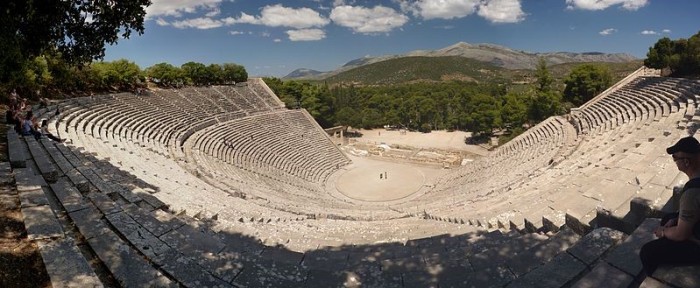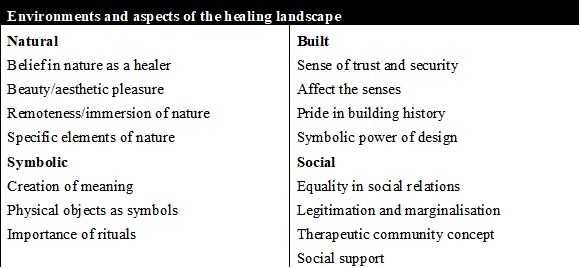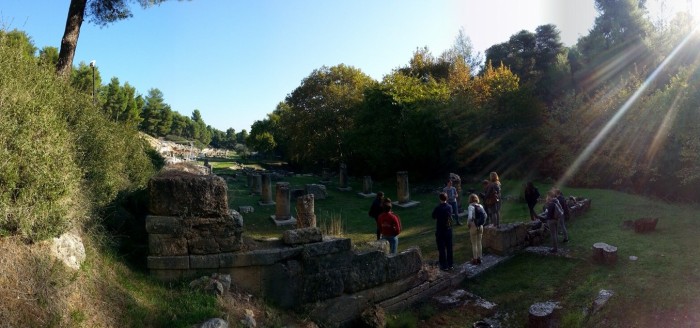Anne-Lieke Brem has written for The Votives Project before, focusing on votive reliefs as ‘things’ and on specialisation in Greek healing cults. She returns here to share her latest thoughts about the significance of healing landscapes.
A few years ago I became intrigued by the Greek Asklepieia and the Amphiareion of Oropos. Not merely by the numerous anatomical votive reliefs found at these locations, but also the locations of these sanctuaries in often remote and peaceful environments. The interpretation of anatomical votive reliefs as representations of body-parts in ill health (main sources: Draycott & Graham 2017; Hughes 2017), and plentiful contemporary debates on the role of the environment on health and healing has left me to wonder how we can place these objects in the larger framework of ‘the healing landscape’ and how we can merge archaeological data and geographical theories, resulting in interesting new insights and/or approaches to the archaeological landscape.

Image 1: View from the theatre at Epidaurus (Photograph: Ronny Siegel, http://www.bit.ly/2HDCZgu)
To briefly explain the concept of the healing landscape: healing landscapes were introduced in the ‘health geographies’ in the 1990’s. They encompass all types of landscapes that have a positive effect on healing – physical, psychological and social – and do not only cover the natural environment (Williams 1999; Gesler 1993). They are contextualised in a wider framework covering also built, social, economic, and symbolic environments. A clear structure of the healing landscape is provided by Gesler (2003), who allocates several aspects to each of these environments (see Table 1, the economic environment is not included in this framework). The aspects may overlap to some extent, and sometimes it is not possible to keep them fully separated. For example: the beauty and aesthetic pleasure of nature are also affecting the senses (built environment), but this is not specified as such for the natural environment. Epidaurus is an example of such an aesthetically pleasing natural environment (still now), in combination with a purposely built theatre to enhance this feature (see image 1).

Table 1: The healing landscape split into four environments with specific aspects (see Gesler 2003, 8, Table 1.1)
So, how do we then analyse an archaeological healing landscape? And, more importantly, what is the role of anatomical votive reliefs in this analysis? Well, first of all, anatomical votive reliefs indicate places of healing in ancient times (whether or not the sanctuary was related to other cults and practices, or even political purposes). And, in the case of the Greek Asklepieia and Amphiareion at Oropos, they indicate that these healing places were often located in natural environments: located away from densely populated areas (or otherwise highly fenced of within these highly populated areas), with splendid views, much greenery and fresh water sources (see image 2).

Image 2: View over the Amphiareion at Oropos (author’s own photograph, 2017)
Secondly, anatomical votive reliefs can tell us some interesting things about social relations and symbolic meanings:
- Anatomical votive reliefs are physical objects (terracotta, valuable metals, wood) with a specific meaning, which are offered in a ritual context. Meaning is created by the person who offers the relief to the god: it is a representation of a (once) affected body part, healed or to be healed by Asklepios or Amphiaraos, offered at a specific place within the sanctuary, where contact with the god would have been most likely (i.e. close to the temple). And, the object is also a visual marker of divine success (Flemming 2017).
- Anatomical votive reliefs indicate a sense of (a therapeutic) community and social support. The reliefs, after they were offered, were likely to be in plain sight: placed on shelves, leaning against walls or hanging from the ceiling. By viewing all of these previously offered reliefs, patients would feel part of a community. They could see that they were not the only ones suffering from an illness, and that there were many others who have or had (depending on the type of offering) health issues.
- The material of which the anatomical votive reliefs was made may indicate social structures. From inventory inscriptions we know that there were also reliefs made from valuable metals (e.g. bronze, gold) and wood. It is unfortunate that many of these reliefs are not preserved. However, we may assume that the reliefs from valuable metals were offered by higher social classes, whereas terracotta’s (mass production) and wooden reliefs were offered by lower social classes. Therefore, we may conclude that these places were visited by people from different societal classes, not only the upper-class.
Besides, anatomical votive reliefs are an indicator of economic activities. They are often locally made (i.e. local production processes) and sold at or near the sanctuary, and provide the sanctuary with an income. This latter environment is however difficult to delineate in the context of the healing landscape and just provides additional information to the functioning of sanctuaries themselves rather than the healing landscape (but still important!).
Of course, anatomical votive reliefs are just part of the full analysis of the ancient healing landscape. The above examples are just to show how these reliefs can be part of a different type of research, where they are not studied on their own, but within a larger framework. Other types of data that need to be taken into consideration are, at least: the architectural remains and material culture, written sources and inscriptions, and, not surprisingly, the landscape itself. Even if the landscape has changed, (systematic) research into (natural) landscapes or landscape features is important because of the sacred characteristics of these places (Bradley 2000).
By Anne-Lieke Brem
References
Bradley, R. 2000. An Archaeology of Natural Places. London: Routledge.
Flemming, R. 2017. Wombs for the Gods. In: Draycott, J. and Graham, E.-J. (eds.) 2017. Bodies of Evidence: Ancient Anatomical Votives Past, Present and Future. London: Routledge.
Gesler, W.M. 2003. Healing Places. Oxford: Rowman and Littlefield.
Gesler, W.M. 2003. Therapeutic Landscapes: Theory and a Case Study of Epidaurus, Greece. Environment and Planning D: Society and Space, 11, 171-189.
Draycott, J. and Graham, E.-J. (eds.) 2017. Bodies of Evidence: Ancient Anatomical Votives Past, Present and Future. London: Routledge.
Hughes, J. 2017. Votive body parts in Greek and Roman religion. New York: Cambridge University Press.
Williams, A. 1999. Therapeutic Landscapes: The Dynamics Between Place and Wellness. Lanham: University Press of America.


